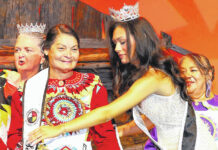PEMBROKE — The Lumbee Tribe of North Carolina, which is linked to settlements in southeastern North Carolina soon will be recognized with a North Carolina Highway Historical Marker.
The marker commemorating the tribe will be dedicated at 3 p.m. July 1 during a ceremony at the Lumbee Tribe of North Carolina Headquarters, 6984 NC 711 West, Pembroke.
The Lumbee Tribe of North Carolina is one of the largest American Indian tribes east of the Mississippi River. Located in southeastern North Carolina, along the Lumber River, tribal territory includes Robeson, Hoke, Scotland and Cumberland counties. The majority of tribal members reside in Robeson County. Significant Lumbee communities also thrive in Baltimore, Maryland, and Detroit, Michigan.
The Lumbee are survivors of tribal nations from Algonquian, Iroquoian and Siouan language families. For thousands of years, the ancestors of the Lumbee belonged to the lands from present-day lower Virginia to upper South Carolina. Post-contact, a variety of factors compelled Lumbee ancestors to converge within the protection of the lands along the Lumber River.
Until 1835, American Indians in Robeson County could vote and had some semblance of rights. Those rights and others were stripped away in 1835 through changes to North Carolina’s state constitution. Then, during the Civil War, many Lumbee ancestors were conscripted and carried away to build Confederate fortifications at Fort Fisher.
The North Carolina Constitution restored voting rights and the right to bear arms to American Indians in 1868. Soon after, in 1885, the State recognized ancestors of the Lumbee, providing them with a new avenue to create their own schools.
The Normal School that grew out of that recognition evolved and became, for about 15 years, the only state-supported, four-year college for American Indians in the entire nation (1939-1953). Today, that school is known as the University of North Carolina at Pembroke.
In 1888, the Lumbee petitioned Congress for federal recognition, gaining partial recognition in 1956. Congress recognized the Lumbee as an Indian tribe but did not provide any federal benefits that are associated with such recognition.
The Lumbee continue to fight for full federal recognition
Tribal headquarters are in the town of Pembroke and the tribe operates several for-profit and non-profit organizations as a means to enrich the lives of all Lumbee People.
The marker is one of nine markers being dedicated in 2024 that highlight American Indian culture and history in North Carolina. Historical markers were approved for the Coharie, Haliwa-Saponi, Lumbee, Meherrin, Occaneechi Band of the Saponi, Sappony, and Waccamaw Siouan tribes. In addition, historical markers were approved for the site of the East Carolina Indian School and the Buie Mound site. The N.C. American Indian Heritage Commission staff worked closely with N.C. tribes to complete applications to be considered for the historical marker program.
About the North Carolina Department of Natural and Cultural Resources
The N.C. Department of Natural and Cultural Resources (DNCR) manages, promotes, and enhances the things that people love about North Carolina – its diverse arts and culture, rich history, and spectacular natural areas. Through its programs, the department enhances education, stimulates economic development, improves public health, expands accessibility, and strengthens community resiliency.
The department manages over 100 locations across the state, including 27 historic sites, seven history museums, two art museums, five science museums, four aquariums, 35 state parks, four recreation areas, dozens of state trails and natural areas, the North Carolina Zoo, the State Library, the State Archives, the N.C. Arts Council, the African American Heritage Commission, the American Indian Heritage Commission, the State Historic Preservation Office, the Office of State Archaeology, the Highway Historical Markers program, the N.C. Land and Water Fund, and the Natural Heritage Program. For more information, please visit www.dncr.nc.gov.










